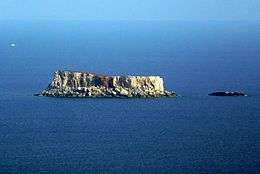Filfla
 Filfla and neighboring Filfoletta seen from Dingli Cliffs (from northwest) | |
 Map of Filfla | |
| Geography | |
|---|---|
| Location | off Malta, south of Sicily, Mediterranean Sea |
| Coordinates | 35°47′15″N 14°24′37″E / 35.78750°N 14.41028°E |
| Archipelago | Maltese islands |
| Area | 0.06 km2 (0.023 sq mi) |
| Coastline | 800 m (2,600 ft) |
| Highest elevation | 60 m (200 ft) |
| Administration | |
|
Malta | |
| Demographics | |
| Population | 0 |
| Filfla | |
|---|---|
 Location within Malta | |
| Coordinates: 35°47′15″N 14°24′37″E / 35.78750°N 14.41028°E |
Filfla is a small, mostly barren, uninhabited islet 5 kilometres (3.1 miles) south of Malta, and is the most southerly point of the Maltese Archipelago. Filfoletta (or Filflett), a small rocky islet some 102 metres (335 feet) southwest of Filfla,[1] has the southernmost point of Malta. The name is believed to come from felfel, the Arabic for a peppercorn.[2]
Environment
Filfla has an area of just 6 hectares (15 acres) and is a crumbling flat-topped limestone plateau surrounded by 60 metres (197 feet) high cliffs. Three species of seabirds breed on the islet: the European storm petrel (with an estimated 5000 - 8000 pairs), Cory's shearwater (c. 200 pairs) and yellow-legged gull (c. 130 pairs). The island has been identified as an Important Bird Area (IBA) by BirdLife International, principally because of the storm petrel colony.[3] A type of wall lizard (Podarcis filfolensis ssp. filfolensis) and door snail (Lampedusa imitatrix gattoi) are endemic to Filfla. A large wild leek, growing up to 2 m (6 ft 7 in) high, also occurs. Access to Filfla is only possible for educational or scientific purposes and visitors must get prior permission from the Malta Environment and Planning Authority.[4]
History
The island of Filfla was possibly sacred to the neolithic inhabitants of Malta, who built the temples of Ħaġar Qim and Mnajdra on the Maltese coast opposite the islet.[4] The Ħamrija Tower, one of 13 watchtowers that Martin de Redin built around the coast of Malta, as well as a memorial to Walter Norris Congreve, one of Malta's British governors, who was buried at sea in the channel between Filfla and Malta, are also located nearby on mainland Malta facing Filfla.
The only known permanent structure on the island was a chapel built inside a cave in 1343, which was destroyed by an earthquake in 1856 that also sank part of the island. A map of Malta dating back to 1798 shows a fort, a lighthouse and a monastery with a chapel on Filfla.[5]
Until 1971 the Royal Navy and Royal Air Force used the island for target practice, and spent cartridges from these bombardments can still be found on Filfla today.[4] It became a bird reserve in 1980. The Filfla Natural Reserve Act, enacted in 1988, provided for further restrictions on access and use, including a prohibition on fishing within one nautical mile (1.9 km) around the island due to the possibility of encountering unexploded ordnance.[2]
Maltese Government notice 173 of 1990 once again permitted fishing within the one mile zone.[6]
Filfla was invoked in a territorial dispute over the continental shelf between Libya and Malta. The case was adjudicated by the International Court of Justice in 1985 essentially by ignoring the islet from the calculations.[7][8]
See also
| Wikimedia Commons has media related to Filfla. |
References
- ↑ "Topography and Flora of the Satellite islets surrounding the Maltese Archipelago" - Arnold Sciberras, Jeffrey Sciberras, 2010
- 1 2 Morana, Martin (2011). Bejn Kliem u Storja (in Maltese). Malta: Books Distributors Limited. ISBN 978-99957-0137-6. Archived from the original on 20 October 2016.
- ↑ "Filfla Islet". Important Bird Areas factsheet. BirdLife International. 2013. Archived from the original on July 10, 2007. Retrieved 2013-08-07.
- 1 2 3 "An island cemetery for bombs on which no one can set foot". TVM. 6 January 2016. Archived from the original on 8 January 2016.
- ↑ Dalli, Kim (28 April 2015). "'Napoleon' map gives a tantalising clue to the past". Times of Malta. Retrieved 29 April 2015.
- ↑ http://www.um.edu.mt/__data/assets/pdf_file/0006/43845/9..Marine_Protected_Areas_in_the_Maltese_Islands_1999.pdf
- ↑ Hance D. Smith (1991). The Development of Integrated Sea Use Management. Taylor & Francis. p. 82. ISBN 978-0-415-03816-4.
- ↑ CASE CONCERNING THE CONTINENTAL SHELF (LIBYAN ARAB JAMAHIRIYA/MALTA) Judgment of 3 June 1985